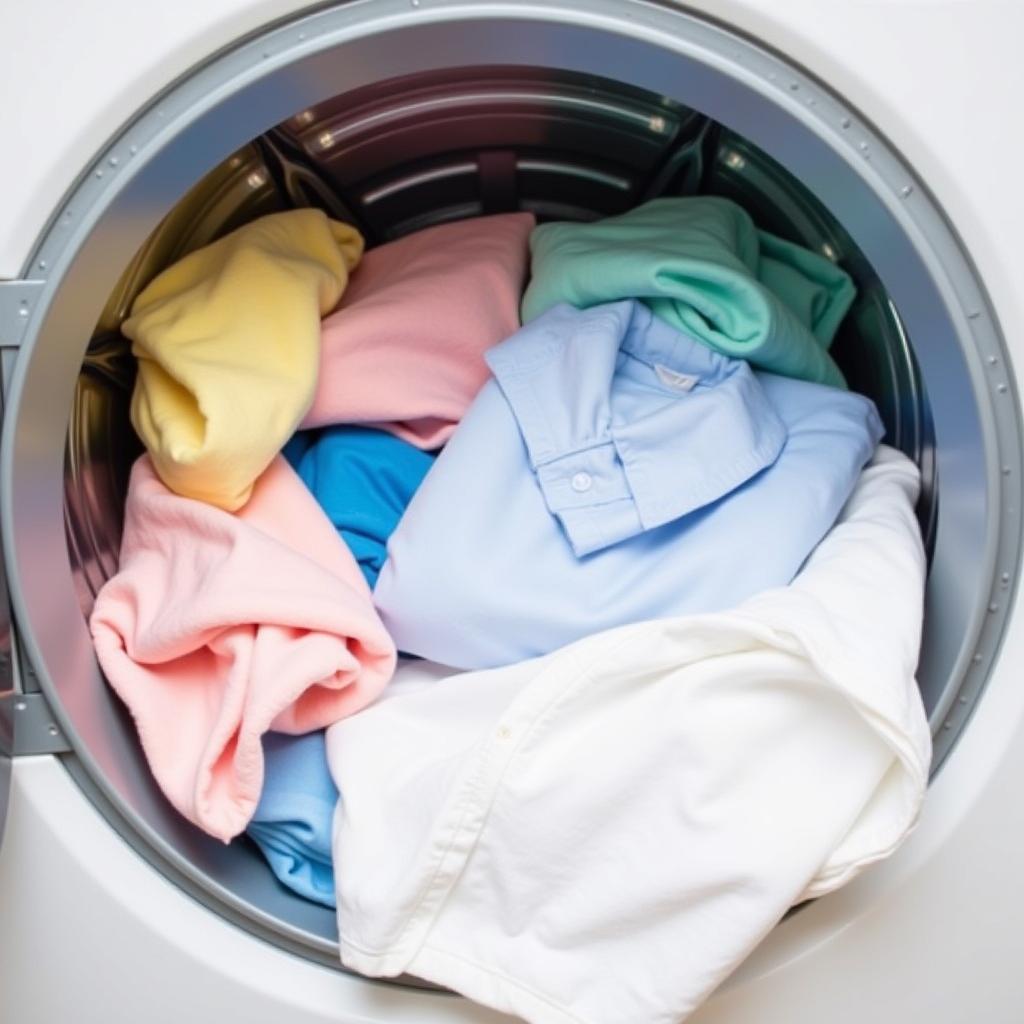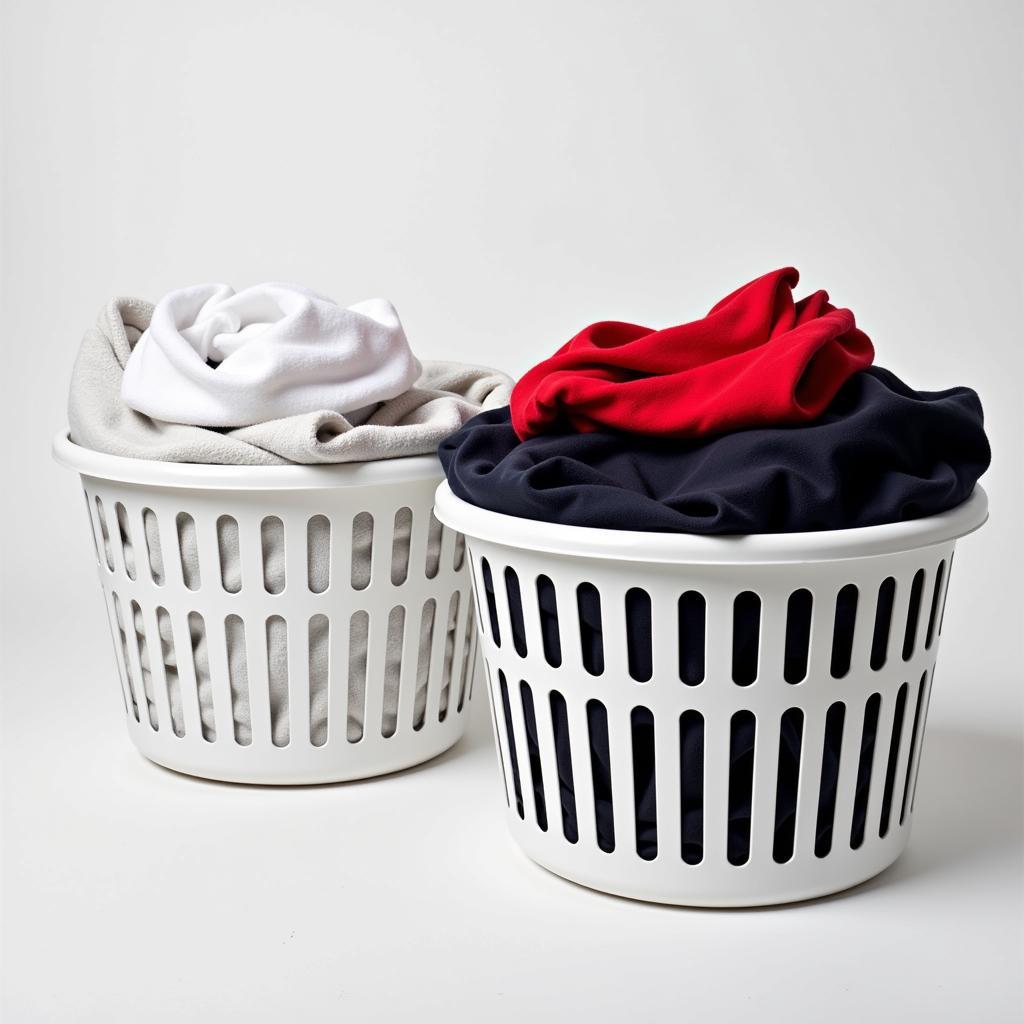Washing a white shirt can be a nerve-wracking experience, especially when you’re worried about color bleeding. The question “can you wash a white shirt with colors?” is a common one, and the answer isn’t always a simple yes or no. While the traditional advice is to separate whites from colors, modern detergents and washing machines offer more flexibility. This article will delve into the science behind laundry, exploring when it’s safe to wash your white shirt with colors and when it’s crucial to keep them separate.
Decoding the Laundry Dilemma: Whites vs. Colors
The fear of ruining a crisp white shirt by washing it with colors stems from the potential for dye transfer. Some fabrics, especially new, brightly colored ones, can release dye into the wash water. This loose dye can then be absorbed by other fabrics, leading to discoloration, particularly noticeable on white items. Understanding the factors that influence dye bleeding can empower you to make informed decisions about your laundry.
Factors Affecting Dye Transfer
Several factors influence whether or not a colored garment will bleed dye:
- Fabric Type: Natural fibers like cotton and linen are more prone to dye bleeding than synthetic fibers like polyester or nylon.
- Dye Quality: Lower quality dyes are more likely to bleed than high-quality dyes.
- Water Temperature: Hot water can loosen dyes, increasing the risk of color bleeding. Cold water washing is generally safer for mixed loads.
- Detergent: Using a detergent specifically designed for colors can help prevent dye transfer.
- Garment Age: New clothes are more likely to bleed dye than older, well-washed garments.
When Can You Wash White Shirts with Colors?
While separating whites and colors is generally recommended, there are situations where washing a white shirt with colors can be acceptable:
- Light-Colored Clothes: Washing a white shirt with light pastels or faded colors is often safe, especially if the garments have been washed several times before.
- Color-Catcher Sheets: These sheets can absorb loose dye in the wash water, preventing it from staining other clothes. They can be a helpful tool when washing whites with colors.
- Modern Detergents: Many modern detergents are formulated to prevent dye transfer and help keep whites bright.
- Cold Water Wash: Washing clothes in cold water significantly reduces the risk of dye bleeding.
 Washing a White Shirt with Light-Colored Clothes
Washing a White Shirt with Light-Colored Clothes
When Should You Absolutely Separate Whites and Colors?
There are certain situations where separating whites from colors is essential:
- New, Brightly Colored Clothes: New clothes, especially those in vibrant colors like red, black, or navy, are highly likely to bleed dye and should be washed separately, at least for the first few washes.
- Delicates: Delicate fabrics, like silk or lace, are more susceptible to damage from dye transfer and should always be washed separately.
- Items You Want to Keep Pristine White: If you want to maintain the bright white of a particular garment, it’s best to always wash it separately.
Tips for Washing Whites and Colors Together (If You Must)
If you choose to wash whites with colors, follow these tips to minimize the risk of dye transfer:
- Turn Clothes Inside Out: This can help protect the outer surface of the garments from dye transfer.
- Wash in Cold Water: Cold water reduces the risk of dye bleeding.
- Use a Color-Catcher Sheet: These sheets can trap loose dye in the wash water.
- Don’t Overload the Washing Machine: Overloading can prevent clothes from washing properly and increase the risk of dye transfer.
- Air Dry When Possible: High heat from a dryer can set stains, so air drying is recommended, especially for mixed loads.
 Separating White Clothes from Brightly Colored Clothes
Separating White Clothes from Brightly Colored Clothes
What if a White Shirt Gets Stained?
If a white shirt does get stained by a colored garment, don’t panic! There are several methods you can try to remove the stain:
- Oxygen Bleach: Soaking the stained garment in a solution of oxygen bleach and cold water can often lift the stain.
- White Vinegar: Soaking the garment in a solution of white vinegar and water can also help remove dye stains.
- Commercial Stain Removers: Several commercial stain removers are specifically designed to remove dye transfer. Follow the product instructions carefully.
Just like knowing what color shirt to wear with khaki shorts, understanding laundry basics is essential for a well-curated wardrobe. This also applies to questions such as what color shorts go with a navy blue shirt. Knowing these principles can help you prevent wardrobe mishaps and keep your clothes looking their best.
Conclusion
The question of whether you can wash a white shirt with colors isn’t a straightforward one. While it’s generally safer to separate whites and colors, especially new, brightly colored items, washing whites with light colors can be acceptable if you take precautions. By understanding the factors that influence dye transfer and following the tips outlined in this article, you can confidently tackle your laundry and keep your white shirts looking bright and fresh. If you’re still unsure, it’s always best to err on the side of caution and wash your whites separately. Similar to the question of can you wash white shirts with colors, knowing can you wash whites and colors together is essential. Or, if you’re interested in color coordination for other clothing items, you might be interested in what color goes with purple shirt.
FAQ
- What is the best way to prevent white clothes from getting stained in the wash? Always wash white clothes separately from colored clothes, especially new, brightly colored items.
- Can I use bleach on white shirts that have been stained by color bleeding? Oxygen bleach is generally safe for white clothes, but avoid chlorine bleach as it can set stains.
- What should I do if I accidentally wash a white shirt with a red shirt? Try soaking the stained white shirt in oxygen bleach or white vinegar to remove the dye transfer.
- Are color-catcher sheets effective? Color-catcher sheets can help reduce dye transfer, but they are not foolproof.
- Is it safe to wash light-colored clothes with white clothes? Washing white clothes with light pastels or faded colors is often safe, especially if the garments have been washed several times before.
- Why do some clothes bleed dye more than others? Factors like fabric type, dye quality, and water temperature can influence dye bleeding.
- What is the best water temperature for washing clothes to prevent dye transfer? Cold water washing significantly reduces the risk of dye bleeding.
Need assistance? Contact us at Phone: 0373298888, Email: [email protected] or visit us at 86 Cầu Giấy, Hanoi. We have a 24/7 customer support team.
